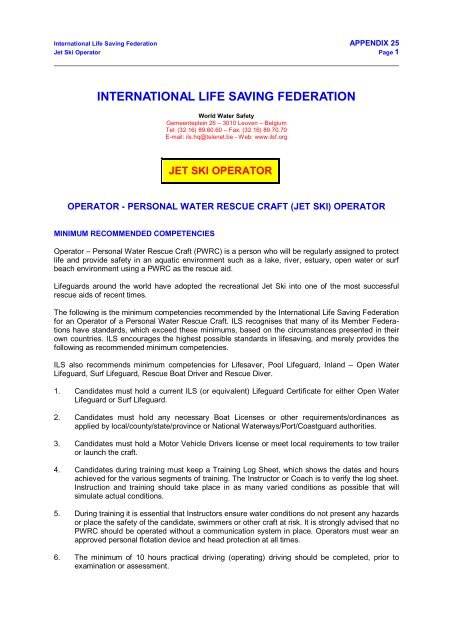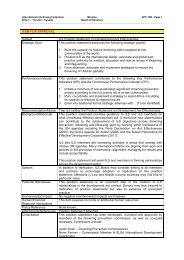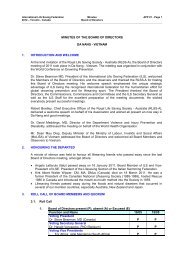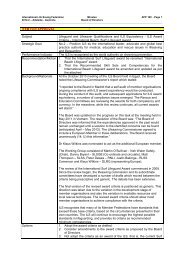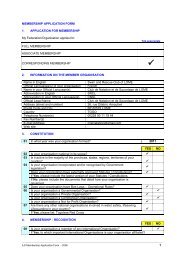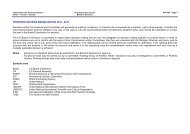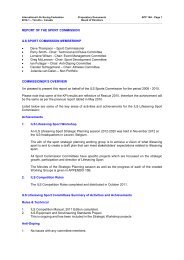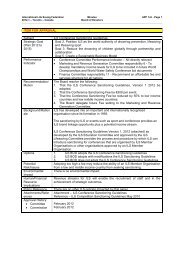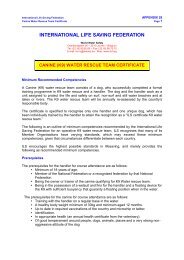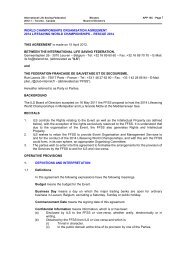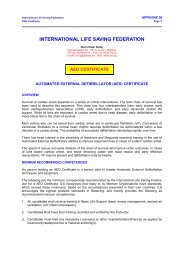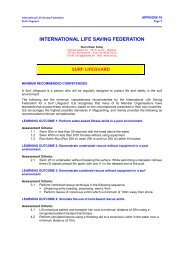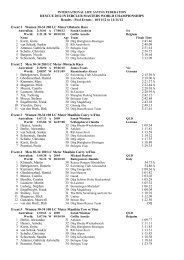ILS Jet Ski Operator - International Life Saving Federation
ILS Jet Ski Operator - International Life Saving Federation
ILS Jet Ski Operator - International Life Saving Federation
Create successful ePaper yourself
Turn your PDF publications into a flip-book with our unique Google optimized e-Paper software.
<strong>International</strong> <strong>Life</strong> <strong>Saving</strong> <strong>Federation</strong> APPENDIX 25<br />
<strong>Jet</strong> <strong>Ski</strong> <strong>Operator</strong> Page 1<br />
INTERNATIONAL LIFE SAVING FEDERATION<br />
World Water Safety<br />
Gemeenteplein 26 – 3010 Leuven – Belgium<br />
Tel: (32.16) 89.60.60 – Fax: (32.16) 89.70.70<br />
E-mail: ils.hq@telenet.be - Web: www.ilsf.org<br />
JET SKI OPERATOR<br />
OPERATOR - PERSONAL WATER RESCUE CRAFT (JET SKI) OPERATOR<br />
MINIMUM RECOMMENDED COMPETENCIES<br />
<strong>Operator</strong> – Personal Water Rescue Craft (PWRC) is a person who will be regularly assigned to protect<br />
life and provide safety in an aquatic environment such as a lake, river, estuary, open water or surf<br />
beach environment using a PWRC as the rescue aid.<br />
<strong>Life</strong>guards around the world have adopted the recreational <strong>Jet</strong> <strong>Ski</strong> into one of the most successful<br />
rescue aids of recent times.<br />
The following is the minimum competencies recommended by the <strong>International</strong> <strong>Life</strong> <strong>Saving</strong> <strong>Federation</strong><br />
for an <strong>Operator</strong> of a Personal Water Rescue Craft. <strong>ILS</strong> recognises that many of its Member <strong>Federation</strong>s<br />
have standards, which exceed these minimums, based on the circumstances presented in their<br />
own countries. <strong>ILS</strong> encourages the highest possible standards in lifesaving, and merely provides the<br />
following as recommended minimum competencies.<br />
<strong>ILS</strong> also recommends minimum competencies for <strong>Life</strong>saver, Pool <strong>Life</strong>guard, Inland – Open Water<br />
<strong>Life</strong>guard, Surf <strong>Life</strong>guard, Rescue Boat Driver and Rescue Diver.<br />
1. Candidates must hold a current <strong>ILS</strong> (or equivalent) <strong>Life</strong>guard Certificate for either Open Water<br />
<strong>Life</strong>guard or Surf <strong>Life</strong>guard.<br />
2. Candidates must hold any necessary Boat Licenses or other requirements/ordinances as<br />
applied by local/county/state/province or National Waterways/Port/Coastguard authorities.<br />
3. Candidates must hold a Motor Vehicle Drivers license or meet local requirements to tow trailer<br />
or launch the craft.<br />
4. Candidates during training must keep a Training Log Sheet, which shows the dates and hours<br />
achieved for the various segments of training. The Instructor or Coach is to verify the log sheet.<br />
Instruction and training should take place in as many varied conditions as possible that will<br />
simulate actual conditions.<br />
5. During training it is essential that Instructors ensure water conditions do not present any hazards<br />
or place the safety of the candidate, swimmers or other craft at risk. It is strongly advised that no<br />
PWRC should be operated without a communication system in place. <strong>Operator</strong>s must wear an<br />
approved personal flotation device and head protection at all times.<br />
6. The minimum of 10 hours practical driving (operating) driving should be completed, prior to<br />
examination or assessment.
<strong>International</strong> <strong>Life</strong> <strong>Saving</strong> <strong>Federation</strong> APPENDIX 25<br />
<strong>Jet</strong> <strong>Ski</strong> <strong>Operator</strong> Page 2<br />
7. The amount of training for the maintenance and unit/engine operation component will depend on<br />
prior experience and mechanical knowledge.<br />
LEARNING OUTCOME 1: Demonstrate knowledge of general safety requirements.<br />
Assessment Criteria:<br />
• Personal protective clothing and equipment.<br />
• Launching, retrieval and operating<br />
• Prevention of accidental or unauthorised starting of PWRC<br />
LEARNING OUTCOME 2: Demonstrate pre-launch (Boat Ramp or Beach)<br />
Assessment Criteria:<br />
• Maintenance and safety gear check including trailer<br />
• Check ‘start ‘ rescue craft<br />
• Transport craft to launch destination<br />
• Identify any hazards at launch area.<br />
• Removing craft from trailer<br />
• Mooring or securing craft in readiness for use<br />
LEARNING OUTCOME 3: Perform Driving and operating procedures.<br />
Assessment Criteria:<br />
• Identify ‘safe zone’ path to enter and return<br />
• Entering and Exiting ‘Surf Zone’ or ‘Shore Break’.<br />
• Reversing and quick stopping<br />
• Turning<br />
• Planning and parallel running<br />
• Wave Judgement<br />
• Precision Driving<br />
• Boarding and starting in deepwater<br />
• Returning to shore and beaching<br />
LEARNING OUTCOME 4: Demonstrate use of communications and responses.<br />
Assessment Criteria:<br />
• Communicate to shore or rescue base.<br />
• Communicate with other craft.<br />
LEARNING OUTCOME 5: Demonstrate Search and Rescue Procedures.<br />
Assessment Criteria:<br />
• Search patterns<br />
• Weather conditions (wind, current drifts)<br />
• Time factors (fuel reserves, crew fatigue, approaching darkness)<br />
• Available back up rescue units<br />
LEARNING OUTCOME 6: Perform rescues, safe approach and determine patient recognition in<br />
conditions that are highly applicable area of operation.<br />
Assessment Criteria:<br />
• Crew drop-off and pick-up<br />
• Conscious Patient Pick-up<br />
• Unconscious Patient Pick-Up<br />
• Multiple two person Pick-Up – conscious patients
<strong>International</strong> <strong>Life</strong> <strong>Saving</strong> <strong>Federation</strong> APPENDIX 25<br />
<strong>Jet</strong> <strong>Ski</strong> <strong>Operator</strong> Page 3<br />
• Mass Rescue – 3 conscious patients (1 patient severely injured)<br />
• Pick-Up near rocks or obstacles<br />
• Transfer patients to shore/beach<br />
• Throwing a rescue line or towrope.<br />
• Pick up object<br />
• Transfer patients to Rescue Boat<br />
LEARNING OUTCOME 7: Trouble shooting and emergency procedures<br />
Assessment Criteria:<br />
• Craft capsize procedures<br />
• Craft submerged procedures<br />
• Re-starting engine<br />
• Clearing weed or debris from jet intake or impeller in deep water<br />
• Towing procedures for inoperative PWRC<br />
LEARNING OUTCOME 8. Demonstrate PWRC retrieval and post operation checks.<br />
Assessment Criteria:<br />
• Secure beach or ramp retrieval area<br />
• Identify hazards at retrieval area.<br />
• Load and secure craft to trailer<br />
• Show knowledge of PWRC operating manuals<br />
• Engine flushing & preventative maintenance<br />
• Final craft and engine checks<br />
• Equipment, sled and gear checks<br />
• Storage – regular and recess periods<br />
• Manufacturers servicing requirements.<br />
• Re-fuelling<br />
• Readiness for use.<br />
ASSESSMENT STRATEGY<br />
These learning outcomes are best assessed using the following common assessment methods. As<br />
many assessment methods as possible should be used to validate the competency of the candidate:<br />
• Observation (personal, video review)<br />
• Oral questioning<br />
• Written Examination (short answer or multiple choice)<br />
• Simulated rescue scenario<br />
• Demonstration<br />
• Self-Assessment<br />
• Third parties<br />
RANGE OF VARIABLES<br />
Variable<br />
Facilities<br />
Venue<br />
Dress<br />
Scope<br />
Facilities and use of inland-open water and surf aquatic locations<br />
Identification of suitable venue that provides the best environment and conditions and<br />
the necessary equipment available to conduct training or assessment sessions.<br />
Candidates may be required to wear their recognised uniform or wet suit along with<br />
required personal protective clothing such as helmet and Personal Floating Device<br />
(PFD).
<strong>International</strong> <strong>Life</strong> <strong>Saving</strong> <strong>Federation</strong> APPENDIX 25<br />
<strong>Jet</strong> <strong>Ski</strong> <strong>Operator</strong> Page 4<br />
Resources<br />
Equipment<br />
<strong>ILS</strong> member organisations will utilise their own materials or those available from other<br />
member countries or reference materials approved by the <strong>ILS</strong> Education Commission.<br />
Patient handling may be with or without a rescue sled attached.<br />
Regulation approved by the <strong>ILS</strong> Board of Directors in 2004 and ratified by the 2004 <strong>ILS</strong> General Assembly.


